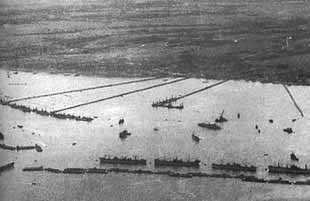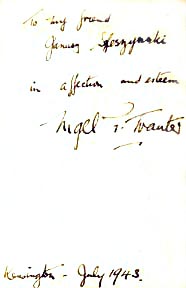![]()
![]()
![]()
![]()

|
JANUSZ' WARTIME ACTIVITIES
Janusz presumably worked with his unit on routine duties until the 1st of March 1943 when another great change came into his life. A change that possible influenced him throughout his post war years and certainly gave him a basic training on which to build his later career.
On that date he moved from Scotland to London on detached duty at the Polish Military Bureau. There, for the next six months, he undertook training at the Foreign Affairs Department of the Polish Government in Exile with General Sikorski as Prime Minister.
On the 1st of September 1943 he was discharged from military service for training in the Polish Diplomatic Service. He held this position for the next eight months before his next major life-changing event.
 All this time the build up to the D-Day landings was in progress and his old unit, back in Scotland, The 1st Polish Armoured Division ( Their badge is on the right) consisting of some 16,000 men and 400 tanks, was moving south down through England ready to move to the theatre of war in Normandy.
All this time the build up to the D-Day landings was in progress and his old unit, back in Scotland, The 1st Polish Armoured Division ( Their badge is on the right) consisting of some 16,000 men and 400 tanks, was moving south down through England ready to move to the theatre of war in Normandy.
Referring to this time in the 'The Lion and the Eagle',Diana Henderson says; Many Scots, especially ladies, were astounded by the Polish good looks and by Polish courtesy. When the Poles left for D Day and the campaign in North West Europe in 1944, a large number of Scottish girls were heartbroken." On 1st August 1944 the 1st Polish Armoured Division, under the command of General S. Maczek landed at Arromanche and became part of the 1st Canadian Army.
As part of his job with the Polish Diplomatic Service Janusz would be very much aware of all this activity in readiness for embarkation. He voluntarily re-joined military service on the 1st of July and was immediately assigned to the Polish Military Mission as liaison with the staff of the Officer Commanding the 21st Army Group.
The 21st Army Group was an important part of the Allied forces and was commanded by Field Marshal Bernard Montgomery. In the early stages it controlled all the ground forces of Operation Overlord but, by the time that Janusz was involved, the American forces were in Normandy and operated under their own Army Group under General Bradley and the 21st Army group comprised the British Second Army and the Canadian First Army. The latter group included the 1st Polish Armoured Division.
 Between his re-enlisting on the 1st of July and the Polish advance into France on the 1st of August we can imagine both the amount and type of liaison that Janusz would be involved in as part of the team that ensured that all the 1st Polish Armoured Division
was in place ready to embark on the 31st of July.
Between his re-enlisting on the 1st of July and the Polish advance into France on the 1st of August we can imagine both the amount and type of liaison that Janusz would be involved in as part of the team that ensured that all the 1st Polish Armoured Division
was in place ready to embark on the 31st of July.
Janusz landed at Arromanche, (this area was codename 'Gold Beach' for the D-Day landings), with the Polish forces. Arromanche was the main area where later troops, vehicles and supplies arrived using the artificial harbour ?The Mulberry? created from massive concrete pontoons towed across the channel and sunk offshore.
Link to a MAP of the Normandy area.
What has been considered by many as the finest hour of the 1st Polish Armoured Division was their part in the sealing of the FALAISE GAP on the 20th August. In this engagement the 1st Polish Armoured Division lost 325 killed, 1002 wounded and 114 missing. The Veterans Affairs Canada have the details of this action listed on their web page written on the 55th anniversary of the battle for Normandy.
On the 23rd of October 1944, when I estimate that the Polish forces would be in the Netherlands, Janusz was promoted to the rank of 2nd Lieutenant.
In terms of Janusz? service a rather peculiar transfer is made quite soon after this promotion. A type of transfer that was, in all, to happen four times in his career and would seem to have been an administrative move for record purposes, colloquially to ?keep the books straight?. On each occasion he was moved to undertake different duties.
On the 15th of November 1944 he was officially transferred from the Military Mission liaison personnel with 21st Army Group to the Armoured Fighting Vehicle (AFV) and Electro-Mechanical Engineering Training Centre (EME). Immediately he is then transferred from the AFV & EME to the Officer?s Record Office and then transferred, 1st of March 1945, back to London to the Polish Government in Exile, Foreign Affairs Department that he had left some 18 months before.
Shortly after, on the 23rd of April 1945, one of the most significant events of Janusz? war came about when, in London, he married Cecile Andree Roches a French woman who was had joined the General deGaule forces and was part of the staff of the French Admiralty based at Stafford Mansions, London.
With victory in Europe in sight, VE Day being the 8th May 1945, another job relocation was to come for Janusz when, on the 1st of May 1945, he was contracted in the rank of Captain into the administrative section of the Centre working on the Military Occupation of Germany Plan. This secondment lasted until the 30th of November 1945 when, he was transferred, once more, to the AFV & EME Training Centre (For record purposes).
This time on the 1st of December 1945 he was released from active service to continue his studies in law at the University of Oxford where a temporary Faculty of Polish Law was set up during WWII. He obtained his Master of Law degree and this completed the Law studies that he had started in Warsaw before the war.
He was recalled from his studies, yet again, to the AFV & EME Training Centre where he reported on the 2nd August 1946 and was sent on detached duty as liaison officer to the Sub District of Agricultural Works.
On the 30th of November 1946 he again reported to the Training Centre and finally on the 2nd of December to the Demobilisation Centre where his war officially ended.
NIGEL AND JANUSZ
Having researched Janusz? war years in detail and knowing a great deal about Nigel my researches, in terms of proving that Cecile?s husband was indeed the Janusz of ?Delayed Action? really failed. Failed because, with my Scottish research, I was unable to prove that both men were in the same place at the same time.
However one of those quirks of fate, that seems to bedevil all researchers, was to provide that necessary proof ---- and from a most unexpected quarter.
 In February 2004, when all the above data was gathered in, but not yet written up, I received an e-mail from Cecile saying;
In February 2004, when all the above data was gathered in, but not yet written up, I received an e-mail from Cecile saying;
?While going through some old papers and books, imagine that I found a book by Nigel Tranter. This book is offered to Janusz with the following
?To my friend Janusz Sleszynski in affection and esteem, signed Nigel G. Tranter, Kensington July 1943.
The book is Mammon?s Daughter and I shall be reading it with a special pleasure ?
Ray Bradfield, in her biography of Nigel, says:
? He spent most of his army service in East Anglia and in and around London with a light ack ack unit, living grandly, for a time, at Kensington Palace, but more often sleeping in a tent on a bomb-site in the East End?.
Returning to Janusz wartime record above we see that, from 1st March 1943 he moved from Scotland, and was posted to work with the Polish Government in Exile. The seat of that body was 18 Kensington Palace Gardens, London.
So for the first time in the research we have the two men in the same place. It is also interesting to reflect that 'Delayed Action', with the dedication to Janusz, was published in 1944. The year after the two of them met in London. Indeed their meeting could well have been the spark that gave birth to the novel.
Now whether they kept in written contact with each other, from their first meetings in Scotland, or whether they accidentally ?bumped into? each other in Kensington is entirely open to conjecture but it does answer the question that was initially posed. Cecile?s husband is definitely the Janusz of ?Delayed Action?.
A bonus to the research was finding, from the MOD, that Janusz was entitled to two war medals that he had not received. I was delighted to obtain them and send them to Cecile.

|

